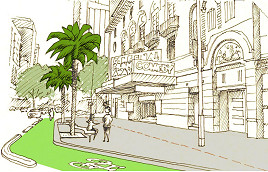The three “Rs”: school’s in at the Old Model School, Spring St
In September 1854, Patrick Davitt and his wife Ellen began their work of instilling the fundamentals of every basic education – the three “Rs” (Reading, Writing and Arithmetic) – on the children who attended the newly-built Model School in Spring St.
The Davitts had been recruited from Ireland to undertake the task of educating young Victorians and aspiring teachers in the Irish system of education, the National Schools system, so it was actually two schools in one – the National Model and Normal Schools but known to us now as the Old Model School. Patrick Davitt was in charge of academics. His wife Ellen looked after the welfare of the trainee teachers and the girls and taught the girls the “various branches of needlework”. A typical education of the time.
Yet this was more than a typical education. The men who led the Model School were first-rate educators. Patrick Davitt, who died in 1860, was a highly qualified teacher, an ex-professor at the University of Paris and an Inspector of Schools in Ireland. The school flourished and within a few months of opening, the pupil numbers had risen from 128 to more than 700. In 1863, another Irishman, Patrick Whyte, took over as head teacher. Whyte, a brilliant scholar and first-rate teacher, was a classicist who taught Latin and Greek. These were not the typical teachers of the time. Nor was this the typical primary school.
This photograph, taken in about 1865, is from the Royal Historical Society of Victoria’s (RHSV’s) images collection and shows you the imposing Spring St frontage of the school with some of its pupils standing out the front. Although you can’t see it here, the building is in the block between Victoria and Lonsdale streets on the north-eastern edge of the CBD. It is just south of the Exhibition Building which now sits majestically in the splendid Carlton Gardens. The Model School, built in the early 1850s, predated the Exhibition Building by almost 30 years and the school’s nearest neighbours were the working-class residents of Little Lonsdale St, known as “Little Lon”, a street bursting with life, full of small, crowded weatherboard cottages and workplaces and with a developing notoriety as a centre for prostitution.
The Model School was the newly declared Colony of Victoria’s central school, but it was also Victoria’s National Board of Education’s administrative headquarters for several decades. As the name suggests, it provided a model for other schools to follow and had separate girls’, boys’ and infants’ departments as well as a teacher training establishment under the “normal” system. Over its lifetime, the Model School, and state education generally, went through a number of changes, including those imposed by the Education Act of 1872 that introduced “free, secular and compulsory” education, until the turn of the 20th century when the declining residential population of the CBD meant school enrolments dwindled and the school closed.
In 1905, the year after the closure of the Model School, a new, exciting and at first controversial phase of state education was played out in these buildings when they opened as the Melbourne Continuation School, the Victorian Education Department’s first foray into secondary education.
At the time, there was nowhere for state school pupils who had completed Grade 8, the final year of primary school, to continue their education, unless they could afford private school fees. Director of Education Frank Tate believed that they deserved their chance at continuing education and so the Continuation School was established. Here aspiring teachers could train, and others could prepare for university entrance.
Although it was co-educational, there was very little interaction between girls and boys at the Continuation School, with separate playgrounds, divided classrooms and a strict rule that boys and girls were not to speak to each other. One female student who attended the school for three years from 1908 remembered that the girls would “never have uttered a word as risqué as petticoat.” She also recalled that when the American Fleet visited in 1908, the principal, Joseph Hocking, was so appalled at the opportunities it created for the fraternising of the sexes that he gave the girls a week’s holiday!
For two decades the Continuation School (called Melbourne High School from 1912) provided secondary education to Victorian girls and boys in these buildings. In 1927, the boys moved off this site to Melbourne High School at Forrest Hill, South Yarra. The girls languished in increasingly dilapidated conditions on the Spring St site until they, too, moved – in 1930 – to Government House, then to the King Street Central School and finally, in 1934, to Mac.Robertson Girls High School in Albert Park.
The departure of the Continuation School marked the end of its association with State Education, which celebrates its 150th anniversary this year. The building was demolished in the early 1930s and the Royal College of Surgeons chose the site as its headquarters. They are still there.
To celebrate the sesquicentenary of the ground-breaking and world-first Education Act 1872, the RHSV will hold a conference, “Free Secular, Compulsory”, looking at the history of education in Victoria. October 1 to 2, 2022.

Council endorses office tower at Flinders Lane despite querying car park demolition






 Download the Latest Edition
Download the Latest Edition